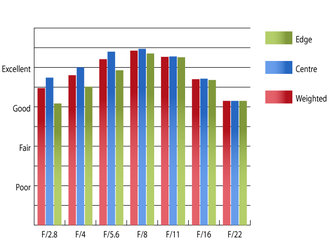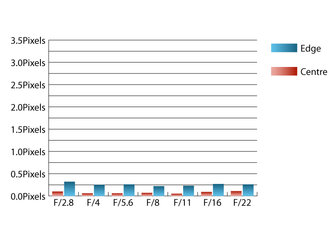Tamron SP 90mm f/2.8 Di Macro VC USD Lens Review
Tamron SP 90mm f/2.8 Di Macro VC USD Performance
Right away at maximum aperture, sharpness in the centre of the frame is very good, with good clarity being produced towards the edges of the frame. Stopping down the aperture improves perforamnce further with outstanding sharpness across the frame being achieved with the aperture set to f/8.  Resolution @ 90mm | How to read our chartsThe blue column represents readings from the centre of the picture frame at the various apertures and the green is from the edges. Averaging them out gives the red weighted column.The scale on the left side is an indication of actual image resolution. The taller the column, the better the lens performance. Simple. For this review, the lens was tested on a Canon EOS 5D Mark II using Imatest. |
Chromatic aberrations very well controlled, thanks to Tamron's use of XLD and LD glass in the optical design. Fringing just exceeds 0.25 pixel widths towards the edges of the frame at f/2.8, which is an extremely low leveland shouldn't pose any issues, even in large prints or harsh crops from the edges of the frame.
 Chromatic aberration @ 90mm | How to read our chartsChromatic aberration is the lens' inability to focus on the sensor or film all colours of visible light at the same point. Severe chromatic aberration gives a noticeable fringing or a halo effect around sharp edges within the picture. It can be cured in software.Apochromatic lenses have special lens elements aspheric, extra-low dispersion etc. to minimize the problem, hence they usually cost more. For this review, the lens was tested on a Canon EOS 5D Mark II using Imatest. |
Falloff of illumination towards the corners is typical for a lens with an f/2.8 maximum aperture at this focal length. At f/2.8 the corners are 1.74 stops darker than the image centre and visually uniform illumination is achieved with the aperture closed down to f/5.6 or beyond.
As you might expect from a fixed focal length macro optic, distortion is virtually non-existent. Imatest did manage to detect 0.13% pincushion distortion, but you'll be hard pressed to spot this low level of distortion yourself.
A deep circular hood is provided to help shield the front element from extraneous light that may cause issues with flare and loss of contrast. Although it is good practice to keep a lens hood in place, Tamron's new eBAND (Extended Bandwidth & Angular-Dependency) lens coatings do an excellent job of suppressing flare and contrast remains good, even when shooting into the light, so the hood may not always be necessary.
Add your message
Login required
Please login here or if you've not registered, you can register here. Registering is safe, quick and free.
Please login here or if you've not registered, you can register here. Registering is safe, quick and free.
photodo Stats
1102 lenses
428 MTF tests
74 in-depth photodo reviews
100+ users join each day
Help the lens community by reviewing or rating a lens today via our lens search
428 MTF tests
74 in-depth photodo reviews
100+ users join each day
Help the lens community by reviewing or rating a lens today via our lens search
Latest Lens Reviews
- Chinon 28mm f/2.8 Vintage Lens Review
- Canon EF 70-200mm f/4L IS II USM Lens Review
- Samyang AF 85mm f/1.4 EF Review
- Sigma 70mm f/2.8 DG Macro Art Review
- Samyang AF 24mm f/2.8 FE Review
- Meike 50mm f/1.7 Review
- Tamron 70-210mm f/4 Di VC USD Review
- Lensbaby Burnside 35mm f/2.8 Review
- Asahi Super Takumar 50mm f/1.4 Review
- Asahi Super-Multi-Coated Takumar 135mm f/3.5 Review
